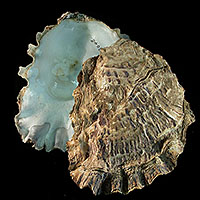|
< Previous family introduction |
|
|||||
 |
Family Ostreidae Oysters
|
|||||
|
The Ostreidae is a numerically large family of mainly intertidal large bivalves that live cemented to the substrate.by the left valve. Most species occur in shallow sheltered water, and some are farmed in that situation. Through cultivation for aquaculture some species that occurred naturally in a restricted area now have enlarged distributions or have become cosmopolitan. There are only a few species found in NSW, but these are so abundant and so ubiquitous because of commercial farming that they are some of the most prominent molluscs on the shore. Oyster shells are very variable in shape within a species, depending on their substrate and situation. Once settled the spat are fixed to the substrate (apart from a few species that become unattached and fall to the bottom after an initial settlement and growth period). They attach to rocks, stones, mangrove roots, or other shells and the lower valve conforms to the shape of the substrate. The shell outline is usually semicircular to oval-elongate, but distorted by its situation, especially by crowding. The left (adhered) valve is usually more inflated or cup-shaped than the right (upper) valve which is usually flat or domed. Oysters have a hinge without teeth and a single large muscle scar from attachment of the adductor muscle. Some species have a series of small ridges (called chomata) on the inside of the shell valve around its margin and their presence or absence is important for identification. Shells are thick and solid but flaky, with unworn specimens showing radial ribs and foliaceous sculpture. Colour is usually some combination of black and purple on a white background. As with other bivalves, oysters are filter feeders, extracting suspended micro-organisms from the water. They must have access to clear water and suffocate when buried in mud. Although they are common, the taxonomy of NSW oysters has had a tortured history, mainly due to shell variability making species definition difficult even today. At the beginning of the 20th century, it was not clear whether the local species were endemic, or part of a regional or a worldwide distribution. For example, the Sydney Rock Oyster was, for a period, considered to be Saccostrea cucullata, which is a widespread Indo-West Pacific species. It then became Crassostrea commercialis with a distribution confined to NSW, and later, through genetic study, it was united with the New Zealand species Saccostrea glomerata. Today the prevailing belief is that most species of oyster have a rather narrow distribution except where they have been spread by aquaculture enterprises. Family Reference Huber’s Compendium of Bivalves provides illustrations of the species worldwide. Thomson (1954) catalogued the Australian species in detail, giving details of the animals, but there has been considerable taxonomic revision since his work was published and all the names have changed, either at the genus level or the species level, or both. Coverage All the NSW species are covered here. Identification Notes As noted above, the shells of oysters are very variable, which complicates identification greatly. Fortunately, there is a small number of species in NSW and they can be separated fairly reliably by a combination of shell morphology and habitat. The shells are long-lasting, but it is not always possible to identify old, incomplete or degraded shells. In addition, there is one species – Ostrea virescens – which is problematic because it is rare and the original illustration appears to be idealised, making recognition of specimens difficult, if not impossible. Common names are included for species for this family because they are very well known and widely used. Additional species Planostrea pestigris (Hanley, 1846) Tiger’s-foot Oyster This warm water species has been reported from NSW by Lamprell & Healy (1998), but the Australian Museum holds no specimens from NSW. However, specimens of a small oyster that matches the description of this species have been discovered growing inside the outer lip of empty specimens of the volute Ericusa sowerbyi from the southern coast of NSW (W. King, in litt). Magallana ariakensis (Fujita, 1929) Suminoe Oyster This species of oyster, that grows extremely large (to 240 mm in diameter), was first detected in Australia in Moreton Bay in 2023. Since then, it has been discovered in a number of sheltered locations in southern Queensland. It seems inevitable its spread will continue into harbours, estuaries and river mouths in northern NSW.
|